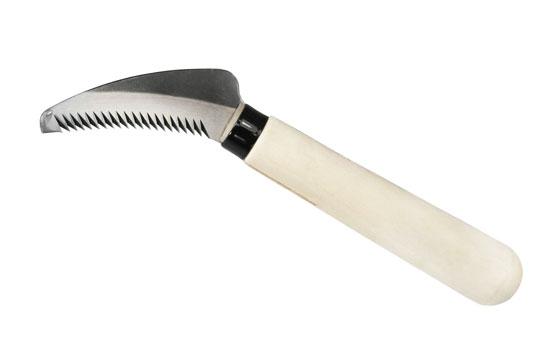Forum Replies Created
-
AuthorPosts
-
The leading sentence of this article reminded me of the 1955 classic book by Ruth Stout, available at the Fern Ridge Library at this link:
How to have a green thumb without an aching back; a new method of mulch gardening.The library is open with reduced hours and curbside pickup, so you might like to check it out?
Hi Karen,
You may like to try some of mine, also just a common horseradish. Following this advice from Johnny’s catalogue, I’d wait until after a freeze:
“Horseradish root can be harvested in late fall or early spring — dug in the fall after a hard frost for a sweeter flavor, or before the plant leafs out in the spring for maximum pungency.”
Aline
Hi Karen & Kate,
My favorite is a Japanese harvest and weeding knife, also! It has a curved and deeply serrated 3 inch blade with a wooden handle. I have worn out a lot of these over the years!

Thanks to Down To Earth, our seed packets and seed greeting cards are now available for online purchase and curbside pick-up! You can pre-order nursery plants and garden supplies, also. Check out the Green Journey Seed page on their website.


I regret missing out on the planting, it sure looks great! And this looks to be a native Iris in bloom? Would you like to post a plant list here, @mikel, please?
Thinking ahead to Saturday, April 25, I see a need to bring more cardboard with us (step 4 above).
The bed we are getting ready for planting is 35 feet long by 3 1/2 feet wide.
Suppose each of us were to remove the quack grass roots along the log edge, as I described above, for say 10-12 linear feet. Seven club members would be needed to complete the task, each doing a modest amount of labor.
If only 2 or 3 of us show up at the same time, the length of this bed will allow us to keep physically distant.
Hi @mikel @edie @cliff and all…
I stopped by the community center briefly on Tuesday.
Here’s my assessment of the current state of this garden.- The sheet mulch is working to suppress the weed growth.
- The cold composting is unfinished and drying out.
- Under the cardboard we have 2-3 inches of soil laced with quack grass roots.
- New grass growth is emerging at the edges.
Here’s the minimum prep that is needed.
- Roll back the cardboard/sheet mulch about a foot from the log border.
- Try not to tear the cardboard, so this covering may be replaced fairly intact.
- Removal of the remaining quack grass roots about a foot in from each log edge.Try to clear all roots close to the log.
- Cover the section you have cleared of weeds with a new piece of cardboard tucked up to the log.
- Replace the cardboard/ sheet mulch.
See how to clear weeds video at this link.
Here’s another short video just about the quack grass removal.
By adopting this plan, we will in effect be clearing 1/3 of the area of the remaining invasive grass roots (a foot in from each log edge).
I’m guessing that our fall prep had already removed the top 2-3″ of these roots, as they generally go down to a 4-6″ depth.
Keeping the sheet mulch in place is important for suppressing quack grass growth within the other 2/3 of the area.Our plan to bring in 2 1/2 yards of planting soil will add about 6″ of height to this bed.
If we soak the sheet mulch before covering the bed with the purchased soil, worms living underneath the cardboard should be able to complete the composting.
The added soil on top of the sheet mulch should continue to suppress this invader, along with regular weeding after planting.
What do you think about this approach?
-
This reply was modified 5 years ago by
 Green Aline. Reason: add user names
Green Aline. Reason: add user names
It is best to wait until May for tender plants like these. Even then, we still have a 30% chance of frost. I wait until after May 10th, and then plant my tomatoes in a cold frame which remains in place for about 3 weeks.
To keep my starts happy until planting time, I’ll transfer them soon from 4″ pots to #1 gallon pots, and keep them indoors under bright light or in the greenhouse.
I arrived at the plant sale last Sunday close to closing time, yet they still had a great selection of starts on their flatbed trailer. A friend who was helping me on the farm that day followed me over to Mayola Lane to buy a box of starts for his garden, too.
Next sale is scheduled for Earth Day, April 22. Time and place to be announced.
Thanks to Phaedra and Brandon of Ambrosia Farm!
Sowing Seeds Indoors
Seeds of tender annuals and tender perennials may be sown in pots indoors in spring, February to April.
These need shelter and warmth to germinate and grow.
After the last frost, these starts may be transplanted out to the garden.Sowing Seeds Outdoors
Seeds of hardy annuals and hardy perennials may be sown directly outdoors March to June, whenever the ground can be easily worked up into a fine seedbed. These will stand some frost and may germinate and grow best at cool temperatures.
Seeds of half-hardy annuals may be sown outdoors in April & May. These need the warmer soil temperatures to germinate. Early volunteer seedlings of sunflowers, and nasturtiums, for example, have emerged in the last couple of days.
Seeds of tender perennials may be sown outdoors in May & June and grown as annuals.
I am open for any questions if you may have about starting your garden with seeds. I’ll be turning my focus to this topic, now.
We can limit the size of the prep group to what feels appropriate.
We can also do the work in several, say 1/2 to 1 hour shifts in order to further “isolate in time” from one another.
I recognize the continued need for physical distancing. Thank you for pointing this out, as we may need to go on well into May with these considerations.
I’d like to propose a pollinator garden prep day 1-2 weeks before planting day.
-
AuthorPosts
